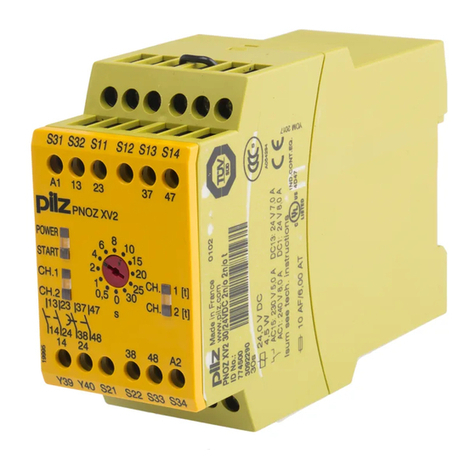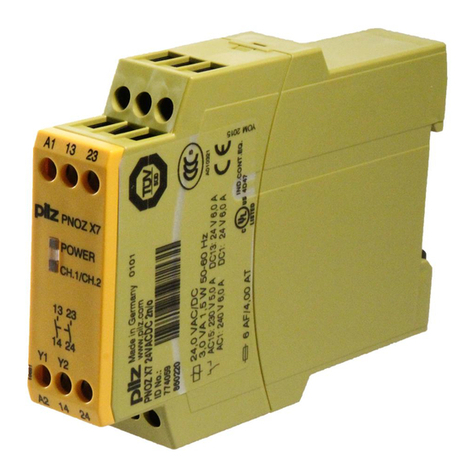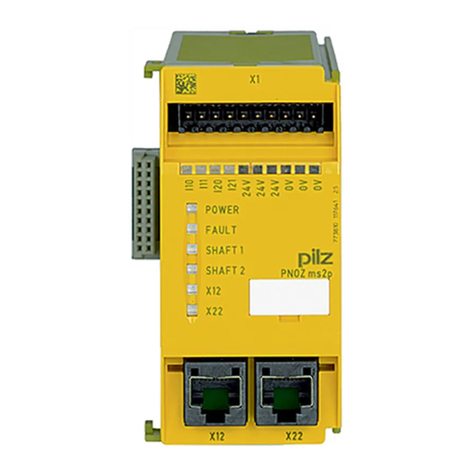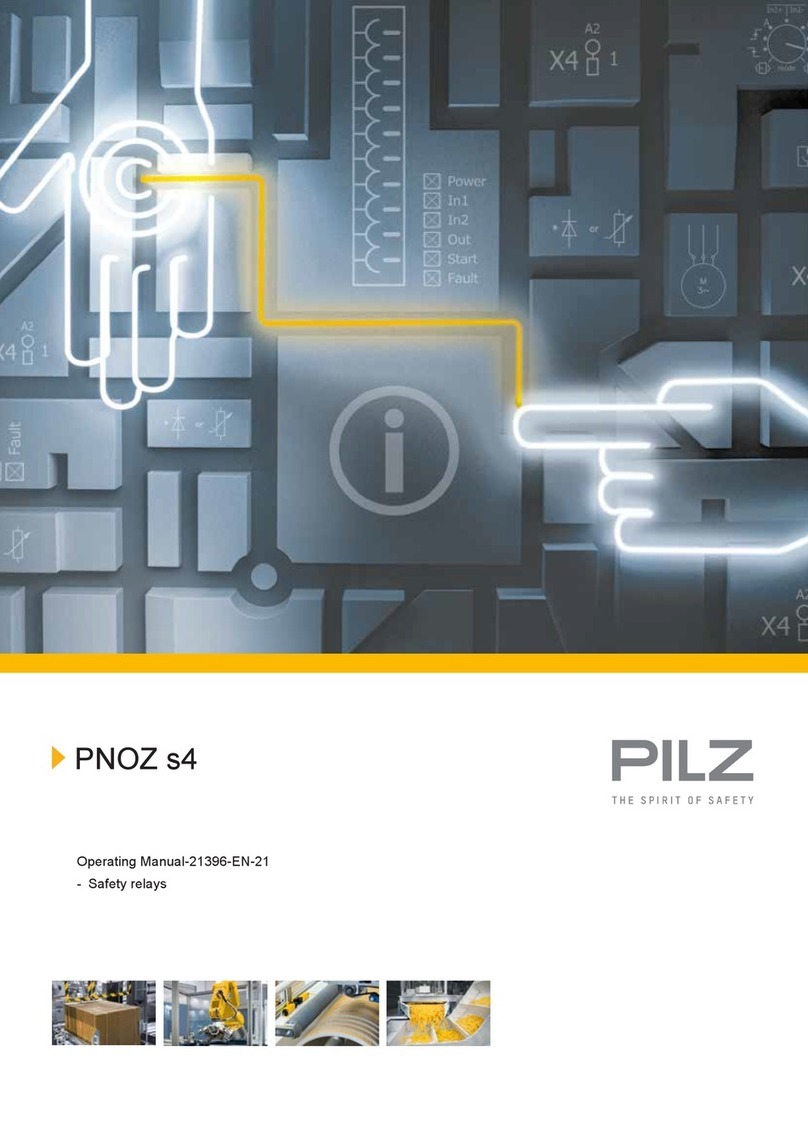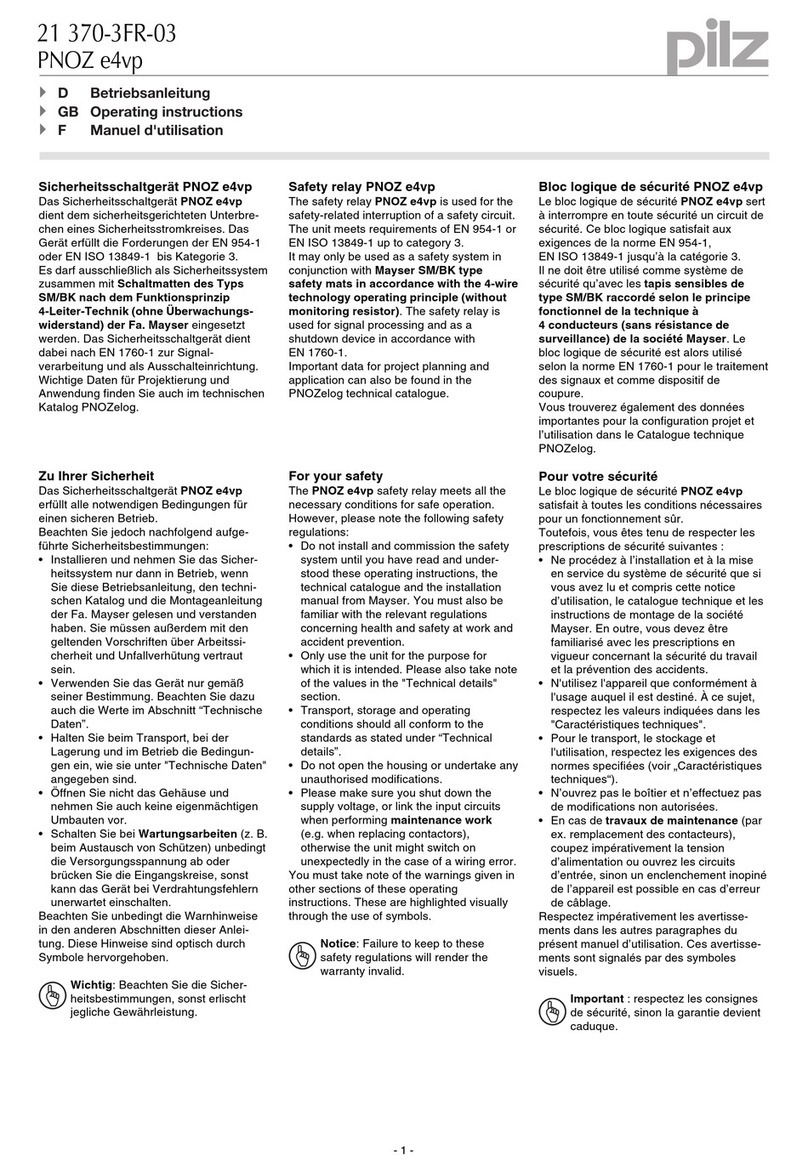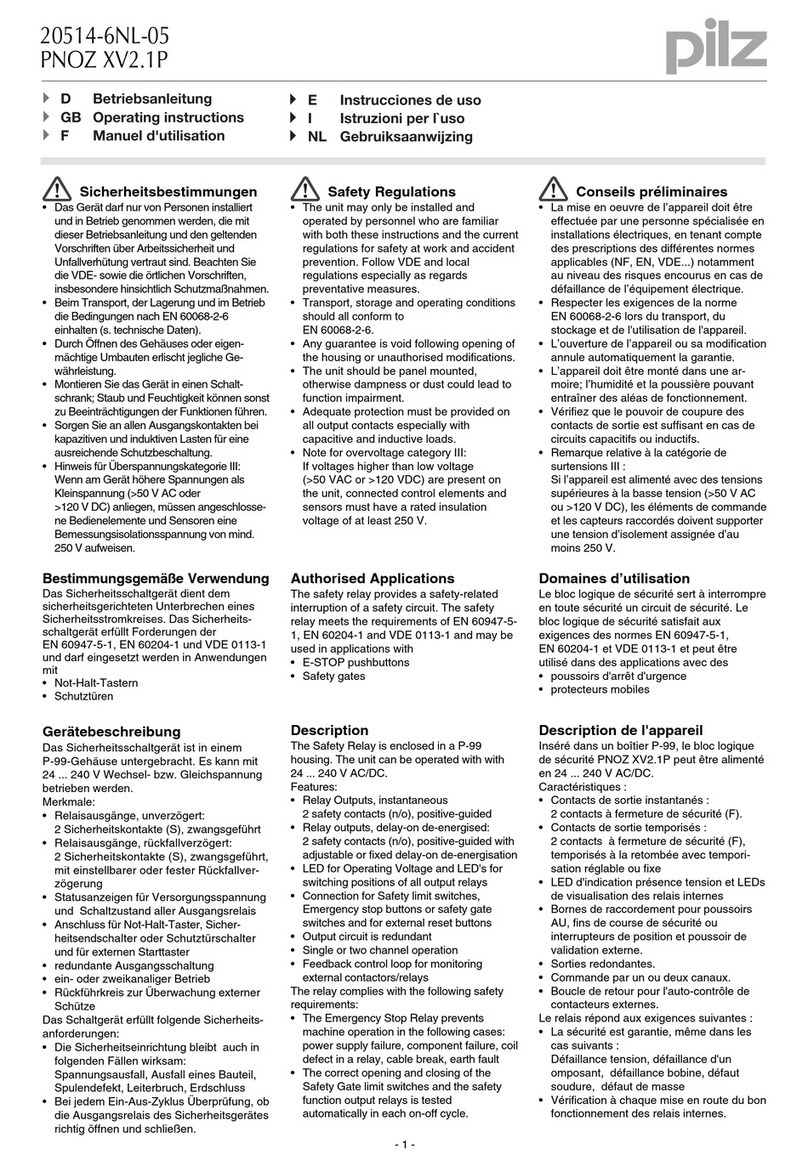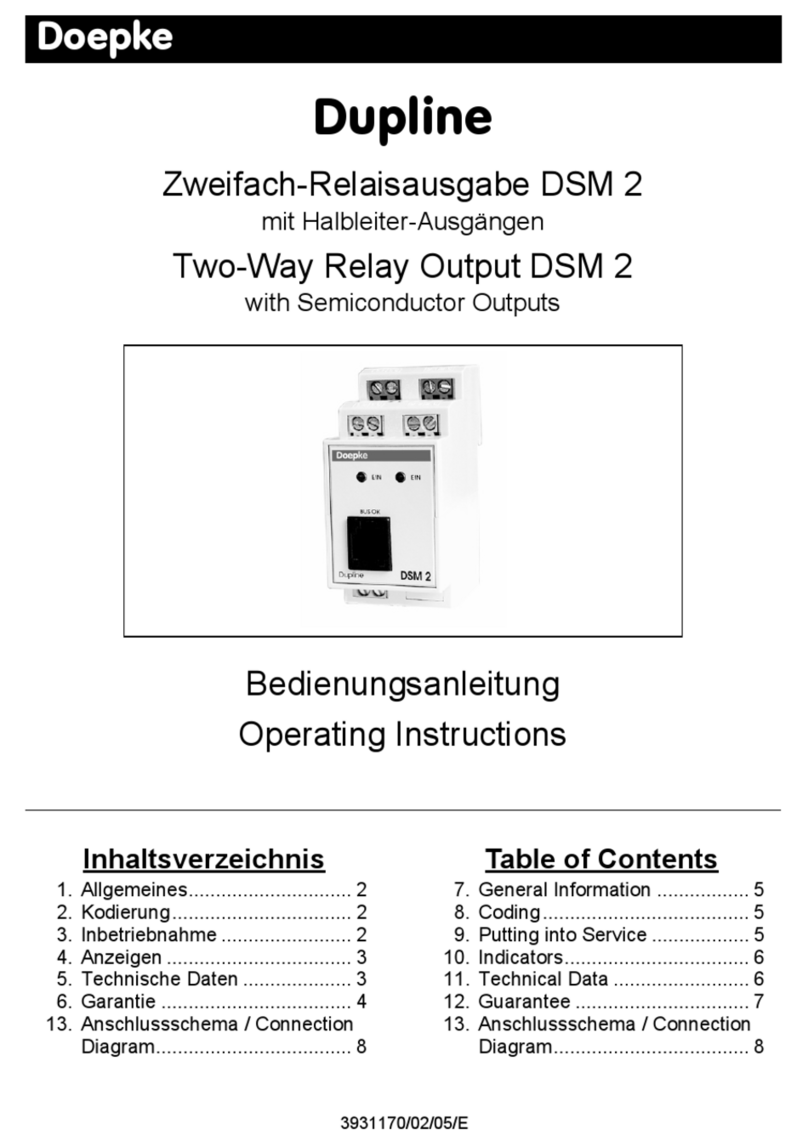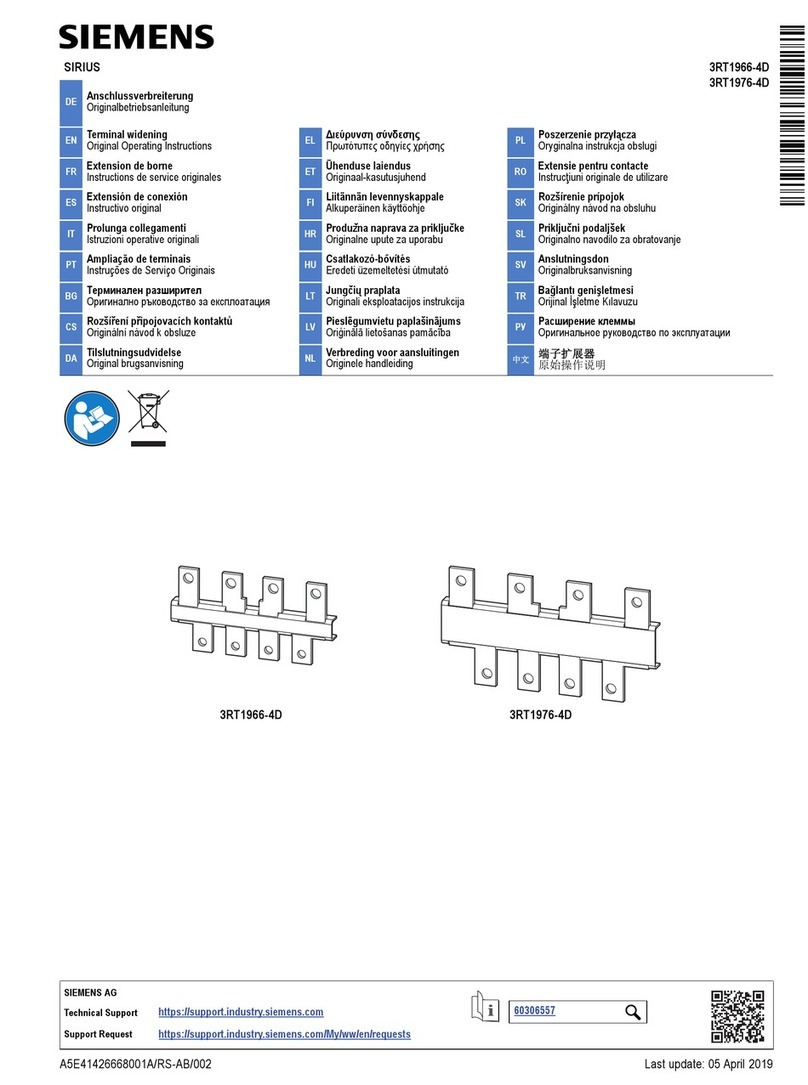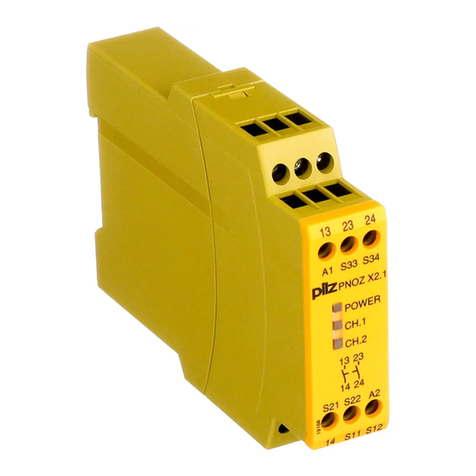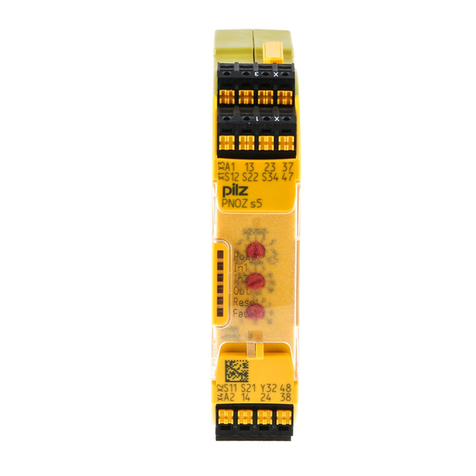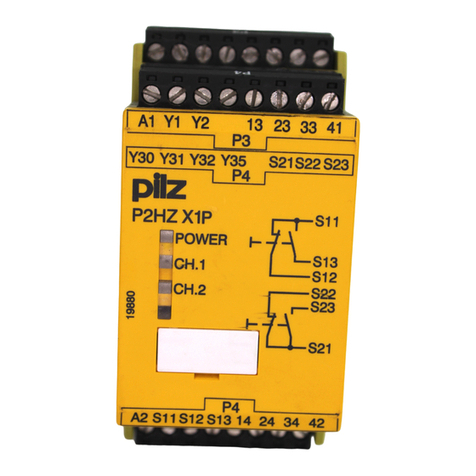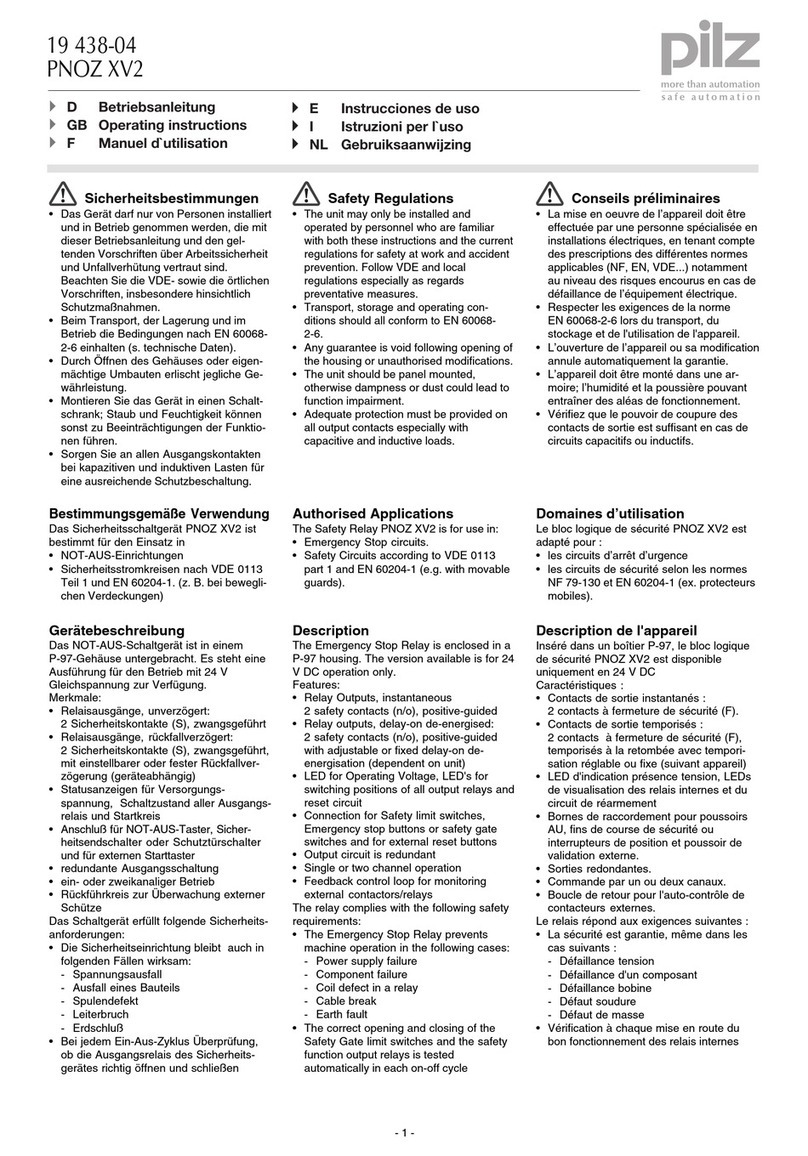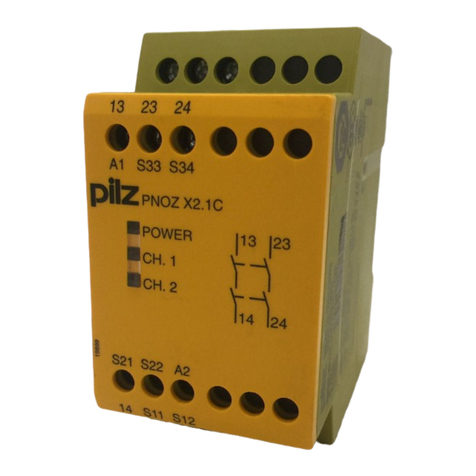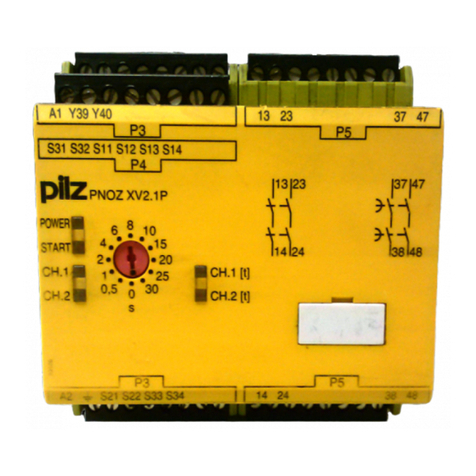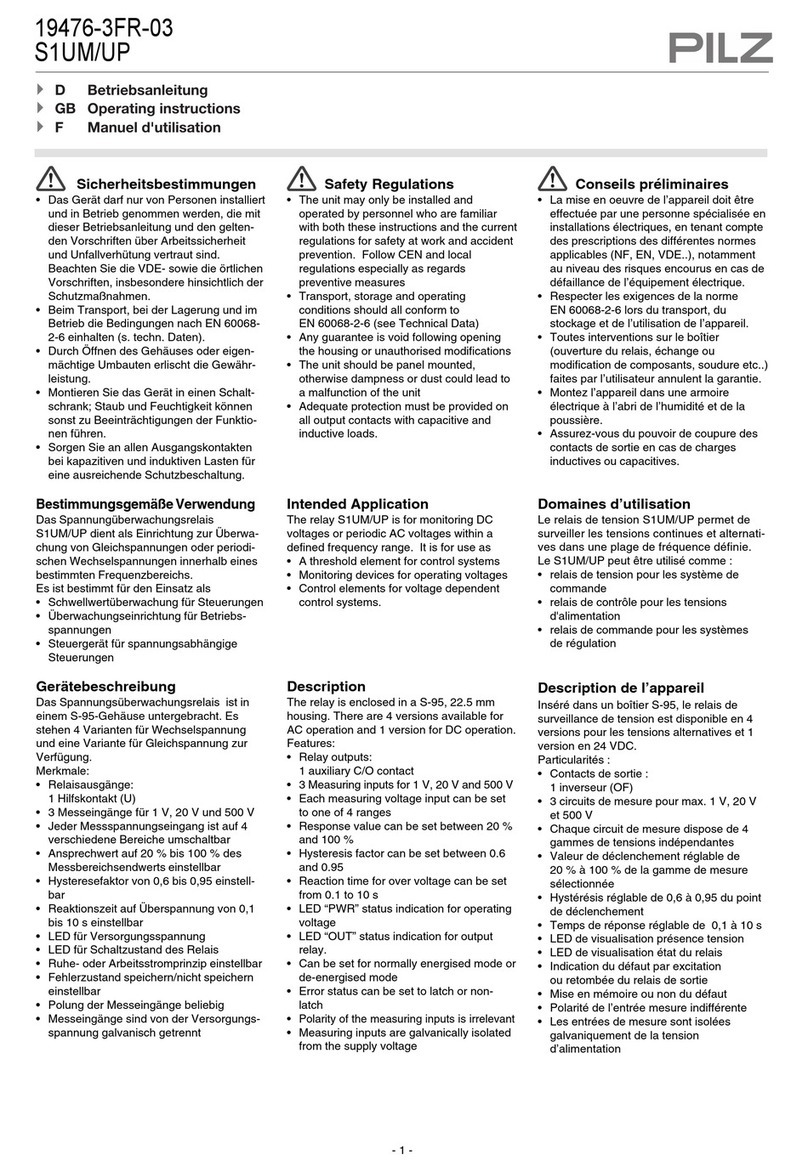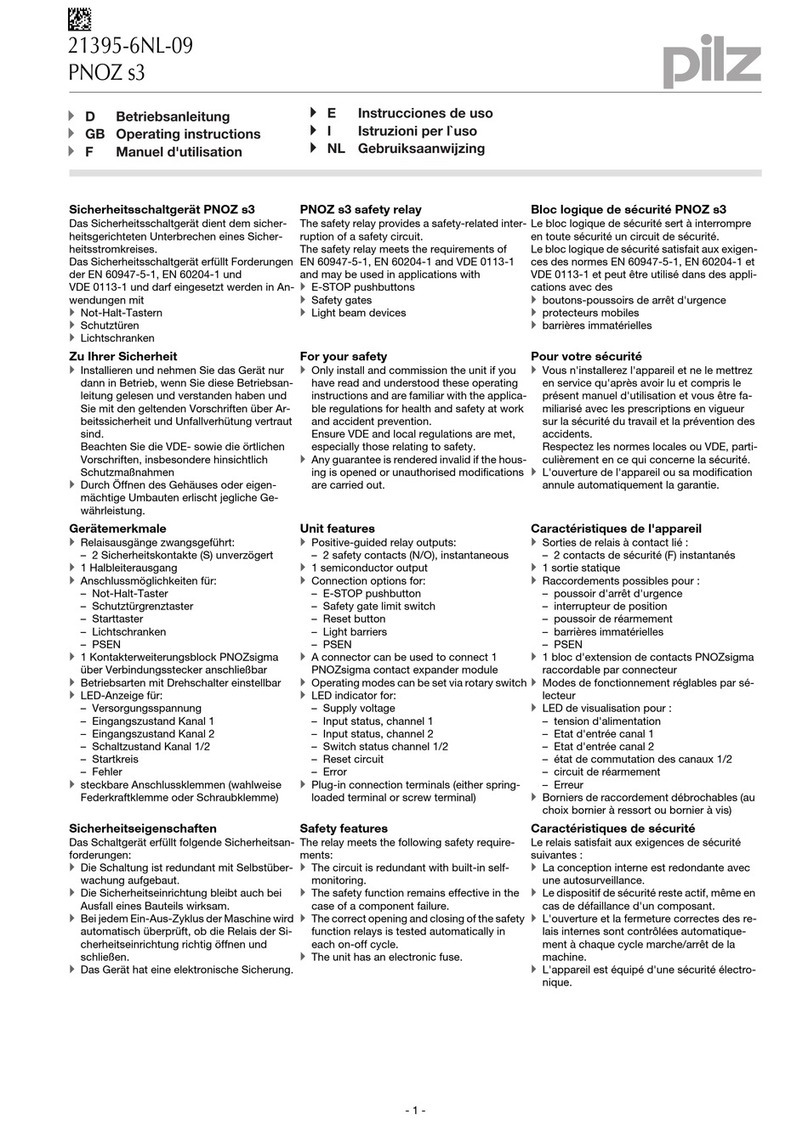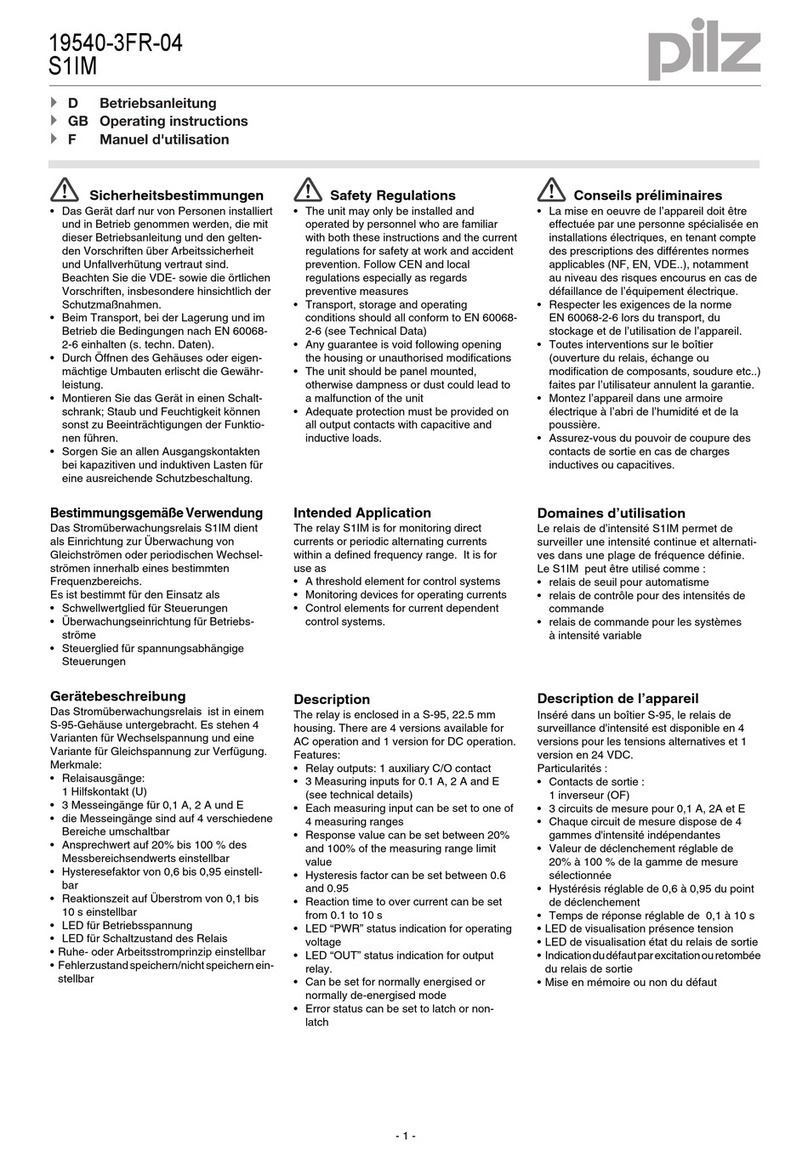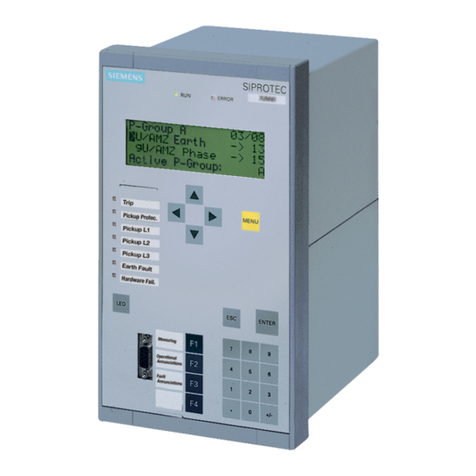
- 2 -
Gerätebeschreibung
Sicherheitseigenschaften
Das Schaltgerät erfüllt folgende Sicher-
heitsanforderungen:
• Die Schaltung ist redundant mit Selbst-
überwachung aufgebaut.
• Die Sicherheitseinrichtung bleibt auch bei
Ausfall eines Bauteils wirksam.
• Die Sicherheitsausgänge werden durch
einen Abschalttest periodisch geprüft.
• Das Gerät besitzt eine elektronische
Sicherung.
Gerätemerkmale
• Ausgänge in Halbleitertechnik:
2 Sicherheitsausgänge, wahlweise
unverzögert oder verzögert, 1 Hilfsaus-
gang und 2 Taktausgänge
• Anschlussmöglichkeit für
Sicherheitsensoren PSEN 2.1p-10 und
PSEN 2.1p-11 oder Positionsschalter mit
Öffner-/Schließer-Kombination
• Rückfallverzögerung einstellbar
• Hilfsausgang umschaltbar als Diagnose-
ausgang
• UND- und ODER-Eingang zur logischen
Verknüpfung mehrerer Geräte
• Querschlussüberwachung durch Takt-
ausgänge
• Statusanzeige
• Rückführkreis zur Überwachung externer
Schütze
Description de l’appareil
Propriétés de sécurité
Le bloc logique de sécurité satisfait aux
exigences de sécurité suivantes :
• Conception redondante avec auto-
surveillance.
• Fonction de sécurité garantie même en
cas de défaillance d'un composant interne
• Les sortie de sécurité sont testées
périodiquement à l'aide d'un test de
coupure.
• L'appareil est équipé d'un fusible
électronique.
Caractéristiques de l’appareil
• Sorties statiques : 2 sorties de sécurité, au
choix instantanées ou temporisées,
1 sortie d’information et 2 sorties
impulsionnelles
• Raccordement possible des capteurs de
sécurité PSEN 2.1p-10 et PSEN 2.1p-11
ou d’un interrupteur de position avec un
contact à ouverture et un contact à
fermeture
• Temporisation à la retombée réglable
• Sortie d'information commutable en sortie
de diagnostic
• Entrées ET et OU pour le couplage
logique de plusieurs appareils
• Surveillance des courts-circuits par sorties
impulsionnelles
• Affichage de l’état
• Boucle de retour pour le contrôle des
contacteurs externes
Descriptif du fonctionnement
Fonctionnement
Deux micro-processeurs analysent les
circuits d'entrée et pilotent en conséquence
les sorties. Les micro-processseurs se
contrôlent mutuellement.
Etat des sorties
• Circuit d’entrée : contact à ouverture
ouvert et contact à fermeture fermé (par
ex. protecteur fermé).
Mise sous tension des sorties de sécurité
14 et 24 (temporisée) et de la sortie
d'information Y32.
• Circuit d’entrée : contact à ouveture fermé
et contact à fermeture ouvert (par ex.
protecteur ouvert).
Blocage des sorties de sécurité 14 et 24
(temporisée) et de la sortie d'information
Y32.
Fonctions
• Si un signal Haut (+24 V CC) est appliqué
sur l’entrée Y5 pendant au moins 250 ms,
la sortie Y32 commute en sortie
diagnostic. Son exploitation est réalisée
via un protocole disponible en tant
qu'accessoire ou développé par
l'utilisateur. Si l’entrée Y5 est ouverte ou
Bas, Y32 fonctionne comme une sortie
d'information.
• Pour le couplage logique de plusieurs
appareils, le PNOZ e3vp possède une
entrée ET et une entrée OU. Les entrées
ont une temporisation de couplage qui est
cumulative dans le cas d’une liaison ET.
• La sortie de sécurité 24 est une sortie
temporisée à la retombée. Dans le cas
où seule la fonction OU est utilisée, la
sortie de sécurité 14 peut elle aussi être
temporisée en retombée. Le temps de
retombée est réglable.
• En cas de défaut, une diminution de la
temporisation à la retombée est possible.
Description
Safety features
The relay fulfils the following safety
requirements:
• The circuit is redundant with built-in self-
monitoring.
• The safety function remains effective in the
case of a component failure.
• The safety outputs are tested periodically
using a disconnection test.
• The unit has an electronic fuse.
Unit features
• Outputs use semiconductor technology:
2 safety outputs,instantaneous or delayed
(optional), 1 auxiliary output and 2 test
pulse outputs
• Connection for safety switches
PSEN 2.1p-10 and PSEN 2.1p-11 or
position switches with combination of N/C
and N/O
• Delay-on de-energisation can be set
• Auxiliary output can be used as a
diagnostic output
• AND/OR input for logic links between
several units
• Test pulse outputs monitor shorts across
the input contacts
• Status display
• Feedback loop for monitoring external
contactors
Function
Operation
Two microcontrollers evaluate the input
circuits and switch the outputs accordingly.
The microcontrollers monitor each other.
Output status
• Input circuit: N/C open and N/O closed
(e.g. safety gate closed).
Safety outputs 14 and 24 (delayed) and
auxiliary output Y32 are energised.
• Input circuit: N/C is closed and N/O is
opened (e.g. safety gate open).
Safety outputs 14 and 24 (delayed) and
auxiliary output Y32 are de-energised.
Functions
• If there is a high signal (+24 VDC) at input
Y5 for at least 250 ms, output Y32
switches to diagnostic mode. It is
controlled via a driver that is available as
an accessory or that you can create
yourself. If input Y5 is open or low, Y32 will
operate as an auxiliary output.
• For logic links between several units, the
PNOZ e3vp has one AND and one OR
input. The inputs have a time delay,
which is added in the case of an AND
connection.
•Safety output 24 has delay-on de-
energisation. If you are only using the OR
function, safety output 14 may also have
delay-on de-energisation. The safety
contacts 33-34, 43-44, 53-54 and 63-64
operate either delayed or undelayed,
corresponding to safety output 14. The
release time can be set.
• Delay-on de-energisation can be reduced
in the event of a fault.
Funktionsbeschreibung
Arbeitsweise
Zwei Mikro-Controller werten die Eingangs-
kreise aus und schalten abhängig davon die
Ausgänge. Die Mikro-Controller überwachen
sich gegenseitig.
Zustand der Ausgänge
• Eingangskreis: Öffner geöffnet und
Schließer geschlossen (z. B. Schutztür
geschlossen).
Die Sicherheitsausgänge 14 und 24
(verzögert) und der Hilfsausgang Y32
leiten.
• Eingangskreis: Öffner wird geschlossen
und Schließer geöffnet (z. B. Schutztür
geöffnet).
Die Sicherheitsausgänge 14 und 24
(verzögert) und der Hilfsausgang Y32 sind
gesperrt.
Funktionen
• Wenn an den Eingang Y5 für mindestens
250 ms ein High-Signal (+24 V DC) gelegt
wird, wechselt der Ausgang Y32 in die
Diagnosefunktion. Die Ansteuerung
erfolgt über einen Treiber, der als Zubehör
zur Verfügung steht oder selbst erstellt
werden kann. Ist der Eingang Y5 offen
oder Low, funktioniert Y32 wie ein
Hilfsausgang.
• Zur logischen Verknüpfung mehrerer
Geräte besitzt das PNOZ e3vp einen
UND- und einen ODER-Eingang. Die
Eingänge weisen Schaltverzögerungen
auf, die sich im Falle einer UND-Verknüp-
fung addieren.
• Der Sicherheitsausgang 24 ist rück-
fallverzögert. Wird keine oder nur die
ODER-Verknüpfung verwendet, kann der
Sicherheitsausgang 14 ebenfalls
rückfallverzögert werden. Die Rückfallzeit
ist einstellbar.
• Im Fehlerfall kann sich die Rückfall-
verzögerung verkürzen.

